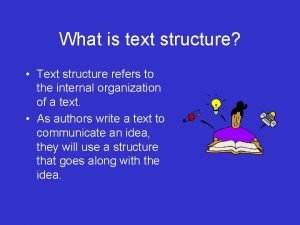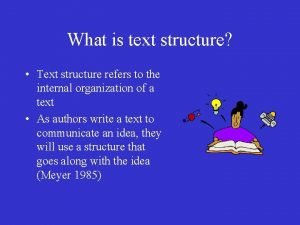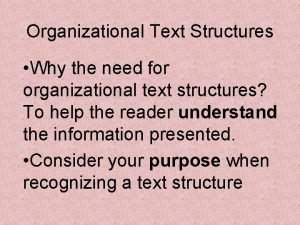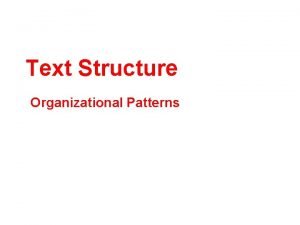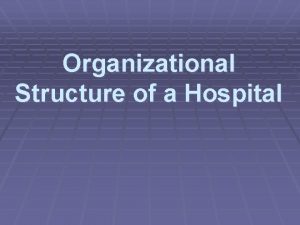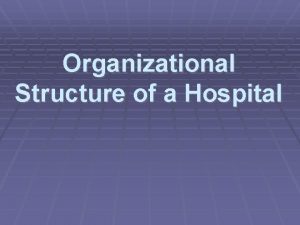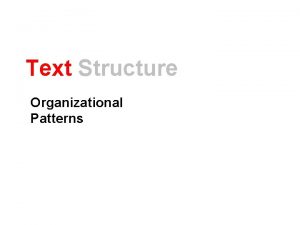TEXT STRUCTURE Text structure refers to the organizational






















- Slides: 22

TEXT STRUCTURE Text structure refers to the organizational patterns that are used by authors to present their ideas and achieve a particular purpose in a piece of text. As authors write a text to communicate an idea, they will use a structure that goes along with that idea.

Purpose: to show to do something or make something, or to relate a series of events that happen over time Also known as time order, sequence, or temporal order This structure is organized from one point in time to another. Transition words such as first, next, later, after, before, following, then, in addition to, followed by, and finally are included to help the reader understand how events relate to one another Dates and times are also used. Questions to ask as we read: How are the steps organized? What is the time span from the first event to the last? How does the author signal the change from one event to the next? What do all of the events explain?

Cause and Effect Purpose: to show why something exists or is in place, to tell what happens as the result of an action or actions, to show one or more causes led to one or more effects This text structure also has a strong time component, since causes come before effects Transition words such as cause, effect, as a result, consequently, so that, because of, since, in order to, are used Many texts do not include just one cause leading to one effect—instead, there may be several causes and several effects Questions to ask as we read: What is the cause? What are the effects? Were there several causes and several effects? How did the cause lead to the effects? How did people react?

Problem and Solution: Purpose: to present a problem, and show it can be (or has been) solved This text structure can be confused with cause and effect The key difference is that problem and solution always has a solution, while cause and effect does not Transitions may include problem, solution, solve, effect, hopeful, concern, challenge, resolve Questions to ask as we read: What is the problem? What are the solutions? Who worked to solve the problem? Has the problem been solved yet, or will it be solved in the future? What caused the problem?

Compare and Contrast: Purpose: to present how two topics are the same and/or different. This text structure is fairly easy for students to understand The text may use a clustered approach, with details about one topic followed by details about the other The text may also show an alternating approach, with the author going back and forth between the two topics Transition words may include like, similar, unlike, on the other hand, also, same as, different from, resembles, yet, as well as, alike, however and too Compare and contrast paragraphs are often embedded in other text structures as an author needs to explain a similarity or difference Questions to ask as we read: What is being compared? What are the similarities? What are the differences? Which similarities and differences are the most significant? Are the details alternating or clustered?

Description: Purpose: to tell what something is, to present an item’s attributes or properties, to show what an item or place is like Helps us visualize and understand a topic Descriptive adjectives help us visualize the topic Explains the characteristics of the subject or topic and uses details Questions to ask as we read: What is being described? How does the author organize the description? Which detail is the most important? How do all of the details fit together?

Proposition and Support: Purpose: To make a claim/statement and support it with details This structure attempts to convince or persuade the reader to follow the views or ideas of the author Signal words include clearly, logically, surely, in conclusion, therefore

“Understanding the expository text structures gives readers a better shot at determining important information when reading nonfiction. . . The text in standardized tests and traditional textbooks frequently falls into one or another of these text structures. If students know what to look for in terms of text structure, they grasp the meaning more easily. ” from Nonfiction Matters, by Stephanie Harvey

Text Structure Examples: Chronological: Goose bumps make me shiver. First I get cold. Then I shake all over. Description: Goose bumps make me shiver. I get little bumps on my skin. They look like sesame seeds. Compare and Contrast: Some people get goose bumps from fear. Others get goose bumps when they are touched emotionally. Cause and Effect: Goose bumps make me shiver. When the temperature drops below 45 degrees, my skin crinkles into goose bumps. Problem and Solution: Goose bumps make me shiver. But they disappear as soon as I cover up with a jacket or sweater.

Text Structure Examples: Chronological: The first day of school is always an interesting day. Description: The first day of school is always an interesting day. Compare and Contrast: The first day of school is always an interesting day. Cause and Effect: The first day of school is always an interesting day. Problem and Solution: The first day of school is always an interesting day.

_______________ The Fire Daniel Sullivan was the first to notice the flames coming from the O’Leary barn at around 8: 30 pm on October 8. A problem with the alarm box made it impossible for the people in the area to call for the fire department. By 9: 30 pm, the entire block was blazing. In another 3 hours, there were fires all over Chicago. The heavy wind coming from the lake only made the fire bigger. It would be another day before the fire would be completely out. By that time, 17, 500 buildings had been burned.

Harry Houdini was born in Hungary in 1874 and moved to Wisconsin when he was four years old. As a young boy, he became captivated by magic when he saw a magician perform. Harry directed his energy to becoming a magician, but some of his first shows were a flop. After five years he almost gave it up. But the “needle trick changed all that. In this trick he swallowed needles and thread and coughed them back up with all the needles threaded through their eyes. Harry was on his way up! Harry went on to perform amazing stunts and tricks including in 1910 escaping out of the mouth of a cannon just before it blew up. No wonder Harry Houdini became a household name. Harry Houdini died on Halloween in 1926.

Diary of the Monarch Butterfly February 19, 2007 — It's too early for spring migration, but monarch butterflies are on the move! They are spreading down the rivers in search of water. These early signs mean the winter season is coming to a close. Monarch butterflies have been in Mexico since November. Can they survive all winter with little or no food? Let's find out. March 1, 2007 — It's March. The days are getting longer and temperatures are rising in Mexico. Within the month these butterflies will leave their winter home and begin the trip to North America. Get ready to track the spring migration. March 10, 2007 — Here come the monarchs! Spring migration begins every March in a flurry. The monarchs are in a race against time. They can't stay in Mexico any longer. They can't move north too quickly either. The timing of their spring migration must be precise. How do they know when to leave, and why do they leave now?

DESCRIPTIVE Icebergs—giant blocks of ice that float in the sea—come in many shapes, sizes, and colors. Some are deep blue or green. Some look like floating sculptures. Old icebergs that have been worn down by the weather sometimes look like pillars of ice. Usually, only about onefifth of an iceberg appears above the surface of the water. The other four-fifths of the “berg” is hidden underwater, out of sight. Sometimes, an iceberg has what is called a “foot, ” an extension completely underwater. These are especially dangerous for ships. It was an iceberg “foot” that sank the Titanic in 1912, killing 1, 503 people.

DESCRIPTIVE Jupiter is one of the nine planets in our solar system. It is called the giant among the planets because it has a diameter ten times as big as the earth. It also has twelve moons! Many scientists believe that the matter of which Jupiter is composed is in the form of a gas; it is not solid like the rock that makes up the earth and the moon. The truth in this hypothesis must await further exploration. Scientists do know that Jupiter’s rotation period is about ten hours, and its revolution period is about twelve years. This means that Jupiter spins very rapidly on its axis as it makes its orbit around the sun. The atmosphere surrounding this planet is probably made up mainly of ammonia and methane, and its temperature is far, far below zero. Since it has no water, no oxygen, and extremely low temperatures, it is unlikely that it could support life. This giant among planets does not seem like a friendly place for humans.

DESCRIPTIVE Humpback Whales The humpback whale is huge. She is longer than a school bus and weighs 35 tons, but she preys on some of the smallest inhabitants of the sea world—tiny shrimp-like creatures that aren’t much bigger than a piece of popcorn called krill. To feed, she opens her mouth wide, taking in hundreds of gallons of water in a single gulp. A humpback whale has no teeth. Instead, attached to its upper jaw are rows of long, thin fingernail-like material called baleen. Each piece of baleen is about three feet long and has bristles at its end that act like a strainer. When the whale takes in a mouthful of water, it forces the water out through the baleen with its tongue, trapping thousands of tiny krill inside its mouth. Humpback whales eat A LOT of krill – up to 4, 400 pounds per meal!

COMPARE AND CONTRAST Oceans and Ponds – How are They Different? To a small child, the ocean and the pond seem very much the same. However, there are important differences to point out. To begin with, a pond is a very small body of water. The ocean covers more than half of the earth’s surface. Ponds are very shallow, but the ocean is several thousand miles deep in most places. Some green pond plants are rooted in mud on the floor of a pond. Because of the ocean’s depth, the sunlight can’t reach the ocean’s floor, hence no green plants grow there. Ponds contain fresh water, which means there is no salt content. The ocean, though, is the largest body of salt water on earth. While they are both bodies of water, there are clearly major differences between the ocean and a pond.

COMPARE AND CONTRAST Different Schools for Aztec Kids Aztec children went to one of two different kinds of schools. One kind was for the sons and daughters of nobility, or wealthy people high up in society. There, children learned to read, write, and do math. They learned to play musical instruments. Some children studied to be priests. They learned the secret language of the priesthood, how to predict eclipses and comets, and how to keep track of the days on the sacred calendar. Other children learned how to work with silver and how to carve wood and stone. The priests were strict with the children at these schools, giving harsh punishments if a child broke a rule. Children of common people went to a different kind of school. The priests were less strict with these children, and they allowed the children to go home sometimes. In both kinds of schools, children learned about religion and war. They learned songs, poems, and dances to honor their gods. They memorized stories of the gods and how they ruled the earth.

COMPARE AND CONTRAST Beastly Bee-havior Scientists have a joke about killer bees: How can you tell the difference between a regular honeybee hive and a "killer" bee hive? Kick the hive and see how far you run! "Regular bees might buzz you for 100 feet or so, " explains insect expert Margaret Mc. Michael. "But 'killer' bees might chase you for two miles!" In many ways, killer bees and honey bees are similar. A killer-bee sting is no more deadly than a regular bee sting. Like killer bees, all honeybees have venom (poison) in their stingers. In many ways, killer bees also behave like regular honeybees. For example, all bees attack when they think their hive is in danger. But some differences in behavior make killer bees more deadly than honey bees. Compared to ordinary honeybees, killer bees have: quick triggers — Unlike a honey bee, it takes very little to get killer bees riled up. "They can sense you walking from about two car-lengths away, " says Margaret. big colonies — Killer beehives can hold more than 50, 000 bees, that is many more than in a honey bee hive. When a killer bee hive is disturbed, there are many more bees to react. staying power — when killer bees get angry, they will chase you for much longer than honey bees will if they are angry. smoke them out: "Smoke makes them think their house is on fire, " says Margaret. "To get energy to fly away, they swallow a bellyful of honey. It's hard to sting with a full belly!" Adapted from Scholastic's Super. Science Blue.

CAUSE AND EFFECT Sunbear: An Endangered Species The sun bear, native to Southeast Asia, is an endangered species for two reasons. First, people in this part of the world hunt the sun bear for body parts such as the gall bladder, the claws and the meat. The body parts are valuable because some people believe that eating them will help heal broken bones and bruises. They believe this because the sun bear appears to fall out of trees without injuring itself. Additionally, special restaurants serve bear paws and bear meat to diners who think that eating this kind of meal will bring good health. In addition to being hunted, the sun bear’s habitat is being destroyed. The jungles where the sun bears live are being cleared to make way for homes and farms. Legendary beliefs can be harmful to nature.

CAUSE AND EFFECT Old Batteries: A Nuisance or a Hazard? When batteries are thrown into the trash, they are harmful to the environment. If batteries are not properly disposed of, they can crack or become damaged. As a result, the toxic substances inside the batteries leak, and the surrounding water and soil are contaminated. Likewise, when batteries are incinerated, or burned, the air is contaminated by toxic fumes. Since incineration produces ashes, the ashes contain toxic substances. Over time, the ashes are buried and the toxic substances make their way into the soil and water. Finally, old car batteries are also harmful because they can crack open when they are dropped. If a neighborhood trash collector drops an old battery in the street or driveway, the toxic contents may spill and pose a health hazard for pets and small children. So it is very important to properly dispose of old batteries to protect our environment.

CAUSE AND EFFECT Populating the Cities In recent decades, cities have grown so large that now about 50% of the Earth's population lives in urban areas. There are several reasons for this occurrence. First, the increasing industrialization of the nineteenth century resulted in the creation of many factory jobs, which tended to be located in cities. These jobs, with their promise of a better material life, attracted many people from rural areas. Second, there were many schools established to educate the children of the new factory laborers. The promise of a better education persuaded many families to leave farming communities and move to the cities. Finally, as the cities grew, people established places of leisure, entertainment, and culture, such as sports stadiums, theaters, and museums. For many people, these facilities made city life appear more interesting than life on the farm, and therefore drew them away from rural communities.
 What is an example of a text-to-media connection?
What is an example of a text-to-media connection? Structure refers to
Structure refers to Common text structures and transition words
Common text structures and transition words Text structure refers to
Text structure refers to Enumeration/listing signal words
Enumeration/listing signal words Text structure spatial
Text structure spatial Hát kết hợp bộ gõ cơ thể
Hát kết hợp bộ gõ cơ thể Frameset trong html5
Frameset trong html5 Bổ thể
Bổ thể Tỉ lệ cơ thể trẻ em
Tỉ lệ cơ thể trẻ em Voi kéo gỗ như thế nào
Voi kéo gỗ như thế nào Tư thế worm breton
Tư thế worm breton Chúa yêu trần thế
Chúa yêu trần thế Các môn thể thao bắt đầu bằng từ đua
Các môn thể thao bắt đầu bằng từ đua Thế nào là hệ số cao nhất
Thế nào là hệ số cao nhất Các châu lục và đại dương trên thế giới
Các châu lục và đại dương trên thế giới Công thức tính độ biến thiên đông lượng
Công thức tính độ biến thiên đông lượng Trời xanh đây là của chúng ta thể thơ
Trời xanh đây là của chúng ta thể thơ Mật thư tọa độ 5x5
Mật thư tọa độ 5x5 101012 bằng
101012 bằng độ dài liên kết
độ dài liên kết Các châu lục và đại dương trên thế giới
Các châu lục và đại dương trên thế giới Thể thơ truyền thống
Thể thơ truyền thống

